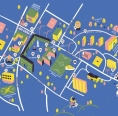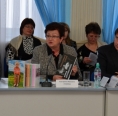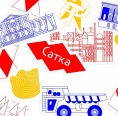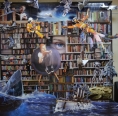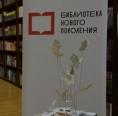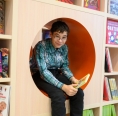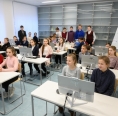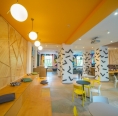-
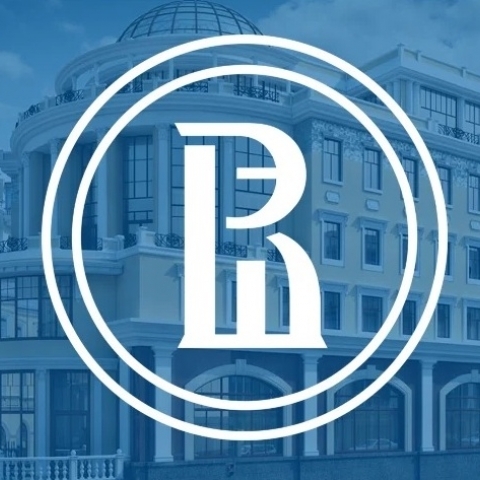
Cooperation with the National Research University
Higher School of Economics
-
Address:
Сатка
Cooperation between the HSE and Sobranie Fund: human capital is the priority
For several years already, Sobranie Fund for Support and Preservation of Cultural Initiatives successfully cooperates with the National Research University Higher School of Economics.
Among the results of this collaborative work is the developed and accepted for implementation Strategy for Social and Cultural Development of the region.
Besides, rigorous research of local human capital was conducted. The cooperation continues and becomes more and more fruitful.
Social and Cultural Development Strategy
Culture of factory workers of the elder age group
Promotion of development of human capital
2014
In July 2014, IV Summer School of the Cultural Studies Department of High School of Economics National Research University will be held in Satka. The subject of this year is Social and Cultural Development of the Russian Municipal District. Not only cultural studies students but also sociologists, journalists and designers are going to receive training in the Summer School. The work of the School is built on the principle of a large research and project laboratory. For ten days, the groups of students and the masters will be working on the projects on development of human capital, culture and history of the district. The level of the projects is expected to be high; some of them have already received support in the form of scientific and research grants.
The Summer School will work as a district summer university where people can attend lectures, share ideas and join the work on their implementation. In addition, the teachers and researchers of the leading educational and scientific centres – High School of Economics, Russian Presidential Academy of National Economy and Public Administration, Saint Petersburg University – are planned to visit the School. The main task of the Summer School is to promote the implementation of the Strategy of Social and Cultural Development of Satka District by enhancing the competence of the students as researchers and practitioners in the work on specific tasks.
2014
On 5 July, for the first time IV Summer School of HSE Cultural Studies Department starts in Satka District (Chelyabinsk Region) at the initiative of the district administration and Magnezit Group. Vitaly Kurennoy, the head of the School, HSE professor, tells about the expectations of the School organizers and participants as well as about its features.
Three features of the School
The first feature of the Schools is less teaching and more real research and practical work. This year, serious scientific projects supported by the leading Russian scientific funds are to be implemented in the framework of the School. The group under the aegis of the social studies department of the Moscow High School of Social and Economic Science is implementing an important social research project, The Culture of Elderly Workers. The project is connected with the task of attentive attitude to elderly people recently mentioned by Deputy Governor of Chelyabinsk Region Boris Dubrovsky in his presentation of the Strategy of Social and Economic Development. In addition, the project on Distributed Life in a Russian Monotown supported by Khamovniki Fund for Support of Social Studies is being partly implemented right in the framework of the School. The School also has groups on development of human capital, development of urban culture and new forms of cultural policy. Another group will make researches to develop the platform for branding of the district. There will be also a media group responsible for the information support of the School, creation of series of important information products about the district, including hi-tech shooting of sights, promotion of the information about the district in the global information and navigation services. The second important feature of the School is its systematic connection with the Strategy of Social and Cultural Development of Satka District as well as with the activity of the Council of Experts of the Fund for Promotion of Satka Municipal District Development. The work of the School will result in the proposals for the Council of Experts and Overseers of the Fund, which means reasoned support of the Fund projects.
Plans
Despite compressed research schedule, lots of events are planned. Meaningful World interactive seminars of the School in summer camps for children and youth of the district, project seminars at schools – all these events are to be held by the group of human capital development in active cooperation with head of Education Department of the District Elena Baranova. The workers of culture and leisure institutions who have joined the School will have the opportunity to take upgrade training courses on modern forms of cultural policy. The course participants will receive the School certificates of our university. As for mass events, I would like to mention the club session, including watching and discussion of one of the modern popular serials. Meetings with special guests of the School, for example, chef editor of Russian Reporter magazine Vitaly Leibin will be arranged. Ruslan Khestanov, HSE professor, the director of the Moscow Institute of Social and Cultural Programs, has scheduled an interesting program of work with local and corporate mass media.
Wishes
I would like to wish the School participants to make the most of this time to communicate and make friends as well as to implement the scheduled projects.
2015
The Design Laboratory of the High School of Economics has created the brand concept of Satka (Chelyabinsk Region) based on the results of the study carried out in the region by the students and scientists of HSE Culture Research Laboratory.
Satka District and Satka Town became the subject of research of the High School of Economics as far back as 2013 when HSR Culture Research Laboratory directed by Vitaly Kurennoy held field studies in the region which resulted in the Strategy of Social and Cultural Development of the District. During IV HSE Summer School for the Study of Culture, the scientists of the university together with the students conducted several researches in Satka District, in particular, the research of distributed living, human capital development, town culture and other.
To create the brand platform, a series of in-depth interviews and polling of the natives were held as well as the focus group managed by professional sociologists. The results were used by HSE Design Laboratory to develop the branding of Satka District and Satka Town.
Three final concepts of the branding are based on the ides of synthesis of nature and material industrial facilities. The industrial and nature paradigms complement each other and allow to create the style uniting the residential areas of Satka District in one visual space preserving and emphasizing their identity.
Concept no.1 (Sergey Kleshchev, the art director of HSE Design Laboratory).
The concept is based on the principle of the multi-function graphical construction kit. It allows to create any element of the town style: navigation (boards, direction signs, leaflets, maps, signs), souvenir (cards, magnets, stickers, badges, pendants), documentation (forms, business cards, stamps, envelopes), typographical (posters for the town, film festivals, town celebrations). The advantage of the construction set is the possibility to add the infinite number of new elements. The suggested logo is the new interpretation of the town emblem which combines the natural and industrial dominants of the town – Zuratkul Lake, the South Ural Mountains and mining dumps
Concept no.2 (Protey Temen, an expert of HSE Design Laboratory)
This concept is a dynamic system in which the colour range and flexible contours of the sign changing their form play an essential role. Calm, dimmed colours convey the mood of bleak, composed nature of South Ural, therefore the elements of the brand ‘grow’ in the urban landscape forming its integral part. The town logo developed by Temen is the transformation of Satka symbol graphical elements. Keeping the main idea of the symbol – mountains reflected in the lake – untouched, the logo changes the form according to the task relaying a wide variety of messages: you can see the skyline of industrial plants, growth charts, a compass needle and other.
Concept no.3 (Oleg Pashchenko, an expert of HSE Design Laboratory)
In this concept, the visual dominant of the town brand includes flowing lines. The town logo is expressed in a unique font composition and a graphical element following the contour of the mountain landscape near Zuratkul Lake – one of the main sights of the region. The key ideas of the logo are cosiness and warmth of home grounds, Ural tales of Bazhov, sublime beauty of Satka nature, and two crossing lines symbolize the nature and industry intertwisted in the history of Satka.
2019
Today, Satka launches a new project: "School of the 21st century: Modern Approaches to Education and Learning Environment", deployed with support of "Sobranie" Fund.
Representatives of the National Research University, Higher School of Economics will hold a series of meetings with the heads of the district, library chains and school No. 4. They will discuss the project and plan further work.
Tomorrow, March 19, "Magnezit" Museum will host the seminar for heads and teachers of the district. The invitees include specialists of the National Research University, Higher School of Economics, Moscow City University and education experts. They are ready to answer the burning questions: how to efficiently apply modern approaches to education allowing to graduate competitive school leavers, who are able to adapt to dynamically changing context of education? What do we want from school learning in the 21st century? What basic competences exist, how are they shaped in the era of school digitalization? Cooperation between the school and the university, requirements to the modern educational environment, including its design and engineering are also included in the agenda.
2019
On December 6, the opening ceremony of the Model Central Library was held in Satka.
Satka District received congratulations on this remarkable event from First Deputy Minister of Culture Irina Anfalova-Shishkina, Director of the Regional Public Library Natalia Diskaya, as well as Heads of Cultural Departments and Municipal Libraries of Kusa, Zlatoust, Miass and Asha.
It is worth noting that Satka is one of the first cities to have a library of this kind. Modernization of libraries and creation of new-generation model libraries is one of the priority directions of the national Culture Project. The central library of Satka District also has a renovation project prepared by the employees of the Higher School of Economics and Strelka Institute with the support of Sobranie Fund. The project will be brought to life in the nearest years. The first steps have already been taken with the assistance of the Ministry of Culture of the Chelyabinsk Region. The funds allocated from the region were used to partially upgrade IT facilities and library furniture.
660 model municipal libraries in total are planned to be created in the Chelyabinsk Region to improve the quality of library services.
The library upgrade has created a space for reading and learning, which is intended to completely change the attitude to the library: from a place where one can get a book to a center of newsworthy events, film screenings, discussions, lectures, workshops, performances and conferences.
2019
Information and Library Center, created in Satka school No. 4 named after V.G. Nekrasov with the support of Magnezit Group and Sobranie Fund is a completely different world. Modern, bright, open space has already been called “a wonderful island of happiness” and “the center of attraction of new events”. It was created thanks to the Design School project of the National Research University “Higher School of Economics”.
If you go up to the second floor of the school and look into the left wing of the building, you will find yourself in a different place and understand why the students are not coming, but running here on a break. They want to be the first ones to occupy a cozy place in the birdhouse niches, on bright poufs that look like turtle shell, or on a sofa-transformer. In this student lounge you can not only relax and chat with friends, but also study using a screen (one of the walls of the foyer plays its role along with the role of a magnetic board) and a projector.
Down the hall behind the transparent walls and doors there are three ultra-modern and very cool (both in form and content) audiences: a reading room-library, a computer science room and an IT polygon. Each space arouses admiration: it surprises, inspires, cheers you up, attracts and does not let go... It will be absolutely comfortable here and interesting not only for students and teachers, but also parents, guests, partners of the school on a variety of projects and events.
The initiators and creators of the project, as well as the representatives of partner organizations who helped to implement the idea, and the parent committee came to congratulate the school on the opening of the modern space.
- We would like each school of Satkinsky district to have similar educational spaces opened. All conditions for comfortable classes of students at every age are created here, – Alexander Glazkov, the head of the municipality pointed out and handed Recognition letters for the implementation of the project to the heads of the Sobranie Fund, Magnezit Group, Satkinsky District Development Assistance Fund, the National Research University “Higher School of Economics” and CityPartner Company.
- I am sure that today's event will be further developed, and young people who study here will acquire new professions and will come to work at advanced production, – Vasily Verzakov, the Deputy General Director of Magnezit Group said. He pointed out that the company actively invests not only in the development of the most advanced technologies, but also in the development and education of the younger generation.
- We do it from the heart, – Vasily Aleksandrovich noted, – the main thing is that this development will have no gap between school and vocational education. And a new, modern platform for educational activities will be fully provided with everything necessary, Magnezit Group gives the school a certificate for expansion of library collection, as well as a symbol of the future “Magnezit” – periclase is our most upscale product from the line of the new brand “Russian Magnezit”.
There were many gifts on this day – certificates, books, magnetic marker boards, decoration items, souvenirs and others. There were also gifts of a completely different kind: a seminar was organized for teachers and school administrators on Designing Programs for the Development of Educational Institutions Based on the Data, and ideas for development of the Center and forms of cooperation with cultural and educational institutions were born at a School Information and Library Center as a Modern Information and Educational Environment round table.
- We see how quickly today the environment is changing especially in the business sector, where everything is created to embrace and lure us, to be friendly, and cultural and educational institutions begin to fall critically behind in this regard. When the child is about to enter, he faces the fact that, when you enter an apartment, where everything is created for your comfort, you get into an environment, which has not actually changed since your parents' school days, – said Natalya Logunova, the Deputy Head of the Design School of the National Research University “Higher School of Economics”. – Thanks to the design of the environment, the path of development becomes clear and the development itself becomes possible. Good form never interfered with good content. If you remember the traditional school (for example, in the times of the Russian Empire), it has been always cooler than the environment where children lived. And if we create spaces to which children and adults would like to aspire to, the area becomes the center of the community. Here you start to feel completely different, new projects and networking begin to appear. And when our students were working on the project, they thought about how it could go beyond school and, in particular, influence the urban environment. It can be transformed not only in similar models in other schools, but also push to completely new projects.
The theme of development was further developed in other proposals. So, Elena Kacheva, the Head of the Regional Information and Methodology Center of Chelyabinsk Institute of Retraining and Advanced Training of Education Personnel, noted that the center can become a place for the accumulation of various directions, with the most important ones – upbringing, education and culture. “Here technologies acquire a human face, she pointed out, – the goal is not in the forefront, but the content — why we do it — is. And when business, administration, culture and science perform such wonders, you develop both yourself and others.” Natalya Nikiforova, the Director of the Sobranie Fund, wished the Center to have as many events as possible, which will open new names, create new meanings and forms of cooperation. It will help the school interaction with other institutions — libraries, museums, palaces of culture. Magnezit Group and the company museum can expand library collection with interesting publications and help in organizing all kinds of events for audience of different age.
2020
"Art-Satka" Creative Public Space established in YuURGU branch building starts working today.
This space is extraordinary, vibrant, unique, multifunctional, cozy and very comfortable. Every visitor will be definitively impressed and find an epithet to describe this place. Art-Satka hospitably opens doors for those who wish to visit the place and will become a real revelation for citizens.
IMPORTANT! The space will work without days off from 8.00 am to 9.00 pm with due consideration of any and all restrictions and sanitary norms which should be observed under conditions of increased preparedness and coronavirus prevention. Free entry.
Just before the opening ceremony, Elena Subbotina, Head of Art-Satka, carried out en excursion for a Magnezitovets reporter. We use the courtyard entrance where bicycles created by artist Danila Shmelev “hover”. The first thing we pay our attention to is a big and well-grounded ramp.
“It is the first ramp in this district and is made in accordance with sanitary norms and requirements recommended within the Affordable Environment Program. The door is equipped with a call button. If necessary, a security officer will help disabled people who use wheelchairs and accompany them to the entry. Besides, it should be noted that there is a wardrobe at the entrance (an open system with clothe hangers), navigation for visually impaired people is under creation”, tells Elena Yuryevna and invites us to enter a new art reality.
Right off the bat, we find ourselves in the biggest hall of Art-Satka.
“There are several functional zones here. The first is a waiting zone. If you come to a workshop and you have to wait for its start or if you are waiting for a child who is making art, you can sit here, talk to other people or read books. The library is amazing, it is continuously replenished with different books. Here, you can find books for any age and taste in literature”, continues Elena Subbotina. “There is a kiosk near the library. It is not working now, everything depends on our visitors’ demands: perhaps, we will sell souvenirs or materials for workshops. The request is not ready, we are waiting for visitors’ opinions and wishes.
The first visitors who come to a new world are amazed and want to check everything, see each zone, come with children, friends, relatives... The place is amazing! There all the materials necessary for workshops and even a funny suitcase with special clothes for creating art in the co-working zone. An adjacent room is for children. It is a fairytale and bright place with cute small furniture, the second “floor” and different things for children of 3–7 years old. Adults can leave their children under teacher’s supervision. There is a playroom for teenagers with a big table, a couch with colorful pillows and storage racks with board games. Here, teenagers can watch TV (special collection of programs and movies) or use Wi-Fi.
A photo zone is also very noticeable and amazing. This is a red bath (!) filled with fried potatoes! You will ask: How?! Come and you will see everything. Besides, you can spend your time nice and profitably in our IT zone. It is equipped with 6 work places (including for visually impaired people) with computers and a printer. We also have a small kitchen where you can use a kettle, fridge, dishwasher and tableware. The calmest and quietest place is a quiet room where you can paint using sand and water, relax and take a rest. By the way, here you will feel the connection in time more than in any other place of Art-Satka.
“We maximally preserved the heritage of the Soviet era — floor, columns, bathroom which you saw in the photo zone, ventilation system under the ceiling in the IT zone which became vibrant decoration elements. And this iron oven which was used at the local kitchen and which insistently wanted to stay here: it does not fit any doorways and turned to be very heavy! It was repainted, all doors were closed to preserve safety, and now it is an original art object”, the head of creative public space continues surprising us.
And, at last, we enter the cinema auditorium which is the most spacious area which can be easily transformed. Here, you can get cozy on a two-level raised floor, move tables and chairs, organize film shows, lectures, conferences, seminars and other public events. Along the entire perimeter of this zone, a muffling system will be installed so that people with impaired hearing can spend their time here.
And there is more! There is a zone for a coffee bar, it will start working a bit later, and for now you can work or spend your time with friends in this cozy place. Perhaps, it will be selected by football lovers since a green field is located in the center of the room (of course, we are talking about a board game which is also pretty excitable).
An administer and a moderator will work with visitors. They will show everything, tell you about the place and offer an activity taking into account your interests.
“We are open! Surely, it is a long-waited event, and during the last week everybody asked: when?! Now we are waiting for you and invite you to come to Art-Satka!” says Elena Subbotina. “However, taking into account the epidemiologic situation, we invite individual visitors and small groups up to five people. We will employ such variants and forms of activities in order to ensure the recommended safe distance. Soon, we will have a telephone and a group in social networks. Stay tuned. Welcome!”
FOR INFORMATION:
Sobranie Fund received the grant of the President of the Russian Federation in order to establish Art-Satka creative public space. The project is supported by the Administration of Satkinsky District and Magnezit Group.
The area for a new object was selected taking into account logistics and accessibility for residents. YuURGU branch building is located in the downtown, there are administrative buildings, educational institutions, art objects, parks near the place. So, it may become a mecca for residents and tourists.
Let us remember that the goal of establishing Art Satka creative public space is to organize a modern platform for social, cultural and intellectual leisure among residents of Satkinsky District. There are several functional zones equipped with multimedia equipment as well as with equipment for disabled people. It is planned that Art-Satka will become not only the place for spending time but a convenient communication platform aimed at forming and developing public initiatives, exchanging knowledge and information, organizing various events for different audience.
"Art-Satka" in social networks: Facebook, VK, Instagram. Website - https://www.artsatka.com/
2020
“Satka Beyond ART-Satka” is a walking route. It “collected” everything most interesting and amazing that makes the town modern and intimate. You can walk from one place to another. All of its landmarks are presented in the original brochure with a map, diagrams and brief information about “Places Worth Seeing”. It was created together with the Higher School of Economics and submitted to ART-Satka, the creative public space, and the Magnezit Museum on the eve of the New Year.
The opening of ART-Satka, the creative public space, in August 2020 undoubtedly became the most significant and outstanding gift for all Satka citizens. Guests of the town also liked this unique center for social, cultural and intellectual leisure activities. Every day ART-Satka welcomes visitors and holds several events. Of course, taking into account the current circumstances, all safety and prevention measures are observed. More than 12,6 thousand children and adults visited the space between August and December. We come up with and implement new projects together with a small and wonderful team. “Satka Beyond ART-Satka”, a walking route, and its original brochure, created together with the Higher School of Economics, are among them.
“ART-Satka, opened in August 2020, now is a “center of gravity” for citizens and tourists, a place for recreation and intellectual leisure activities.
The creative public space is located in South Ural State University Branch, at the address: 6, ul. Proletarskaya. It has administrative buildings, educational institutions, art objects, parks around, i.e. it is a very good location, in the heart of Satka’s social life,” the information page of the brochure informs, “Here you can enjoy the magnificent atmosphere of an intimate town, where modern urban facilities together with historical and cultural heritage of the Soviet past form an ideal balance. This is one of the reasons that inspired the creators of ART-Satka.
We invite you to discover most remarkable artistic events for the last five years. You will see how they are embedded in architecture of XX century and renovated urban infrastructure.”
You can start an exciting journey from any route point that is indicated on the map and described in the “Places Worth Seeing” section. All landmarks are located close to each other: the splendid Magnezit Community Center, Proletarskaya, the renovated central street, Devyatnar, a historical block of standard Soviet housing, Satka “Road of Life”, the Magnezit museum. And, of course, places widely known, created during the international festivals My Satka, Satka Street Art Fest and residences of the Ural Industrial Biennale.
You can plan the route based on your plans and preferences. It is not necessary to go from one place on the map to another sequentially. Even a glance at the modern Satka landscape around the new art space gives a sense of changes occurred. They transformed the industrial Ural city into a creative capital of the Chelyabinsk Oblast.
We wish you a pleasant journey and new experiences.
***
"ART-Satka" is the unique public space, combining educational and creative components. Here you can rest, read a book, spend time with friends or work on your project. ART-Satka offers lectures, seminars, film screenings and many other events.
The library space is regularly replenished with books from major publishing houses and museums, universities and culture centers of embassies of various countries.
Master classes as well as participation in creative programs are conducted at the art space on a daily basis. Both children and adults can attend ART-Satka events. Moderators will work with young visitors while parents are involved in creative activities.
The art space is friendly to physically challenged people. It leaves no room for boredom and formalism. ART-Satka is a Satka source of creative strength, club and educational center, all in one place.

